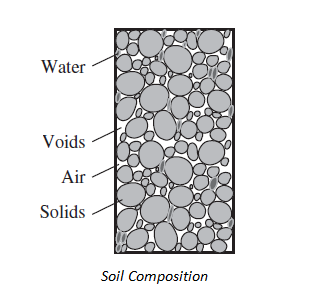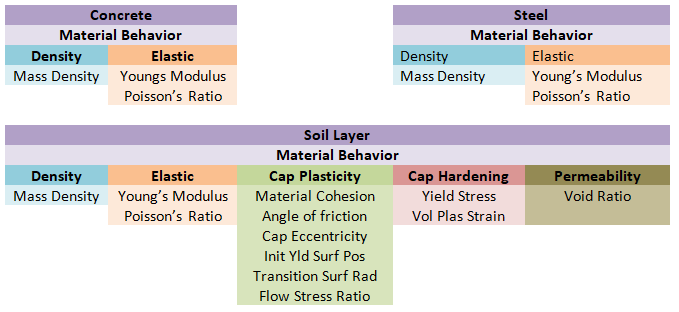
How to perform Geotechnical Analysis of Soil using ABAQUS
The analysis of geotechnical problems is rather complex due to stress dependent material behavior and varying stiffness for loading and unloading conditions. Generally, soil has three different phases which are soil skeleton, pore air and pore water which often lead to complex interaction mechanism. Also, large deformation of soil continuum is observed under loading. Such complex behavior, boundary and material modelling can easily be found out and addressed by ABAQUS.
This blog mainly focuses on ABAQUS capabilities of soil modelling, material modelling, complex loading analysis, boundary modelling and analysis procedures used in geo-mechanics by taking the example of a laterally loaded pile.
Characteristics of Soil:

The typical granular soil composition is of three components viz solid, liquid, and gas. The solid components of soil are solid grains (resultant of weathered rocks). The liquid component is usually pore water (pore fluid), and the gas component is usually air. The gaps between the solid particles are called voids.
When soil is loaded, the pressure in pore fluid gets modified due to which the pore fluid flows and leads to the deformation of soil over a period of time. This deformation of soil can be analyzed by using mechanical and permeability properties of soil along with pore pressure boundary condition in ABAQUS.
Loading Conditions:
Material behavior of the soil is rather complex when compared with other engineering materials. Soil can be differentiated like granular soil (sand and gravel) and soft soil (clay or silts). When granular soils are loaded slowly, there will be a change in volume which results in excessive pore pressure that dissipates rapidly due to high permeability and is called as “Drained Loading”.
On the other hand, when soft soils are loaded, it generates excess pressure which is entrapped inside the pores because of low permeability. This condition is known as “Undrained Loading”. Generally, both loading conditions can be carried out in laboratory by using Tri-Axial test setup. Therefore, in numerous simulations, this complex behavior has to be taken into account.
Material Models:
Several material models are available in ABAQUS including elastic, plastic, pore fluid, concrete damage plasticity, concrete smeared cracking and plasticity models as discussed below.

ABAQUS built-in material model can deal with applications where fully coupled conditions are needed to simulate. There are exceptions where large deformation needs to be modelled with special techniques such as Discrete Element Techniques (DEM). Also, user defined material can be incorporated with VUMAT, UMAT framework. For laterally loaded pile, the following properties are used.

Contact Interaction for Geotechnical problem:
ABAQUS provides two algorithms for modeling contact interaction:
- Contact pair algorithm – it is used where every possible surface pair has to define contact interaction including surface which may come in self contact. It is also based on master-slave definition.
- General contact algorithm – it allows to define many or all regions with single interaction properties. This algorithm automatically decides master-slave surfaces.
ABAQUS also gives flexibility to find contact surface automatically within chosen parts or whole model.

In geotechnical analysis, where blast loading is carried out to analyze the structure load bearing capability, Eulerian domain needs to be defined. In such scenario, general contact has to define and it works very efficiently.
Element Selection:
To model fully or partially saturated fluid flow through a deforming porous medium, ABAQUS provides Pore Pressure Element type which can be used for soil and geostatic analysis. These elements have both displacement and pore pressure degrees of freedom. In second-order elements, the pore pressure degrees of freedom are active only at the corner nodes. Pore Pressure Elements are available for plane strain, axisymmetric, axisymmetric-asymmetric and for three dimensional problems.

Analysis Procedure:
ABAQUS Standard provides two different procedures to analyze the soil problems viz “Geostatic” & “Soil”. Also, soil like material, in case of large deformation, can be simulated using special techniques like
- Coupled Eulerian-LaGrangian Techniques (CEL)
- Smoothed Particle Hydrodynamics Techniques (SPH)
- Discrete Element Techniques (DEM)
Above techniques can be used for offshore foundation, crushing of soft rocks, mining & agricultural industries respectively. For laterally loaded pile the “Geostatic” & “Soil” procedures are used for analysis.
“Geostatic” procedure is normally used as the first step of a geotechnical analysis; in such cases gravity loads, initial stress state, void ratio distribution or saturation are applied during this step. Ideally, the loads and initial stresses should exactly equilibrate and produce zero deformations. The geostatic procedure requires that the initial stresses are close to the equilibrium state; the displacements corresponding to the equilibrium state might be large. “Soil” procedure is used to specify transient (consolidation) or steady-state response analysis of partially or fully saturated fluid-filled porous media.
Mr. Narendra has more than 7 years experience as Project/Process Specialist in Stress Analysis domain. He is currently working as Application Engineer in EDS Technologies for SIMULIA, 3DEXPERIENCE, CATIA Analysis applications.
